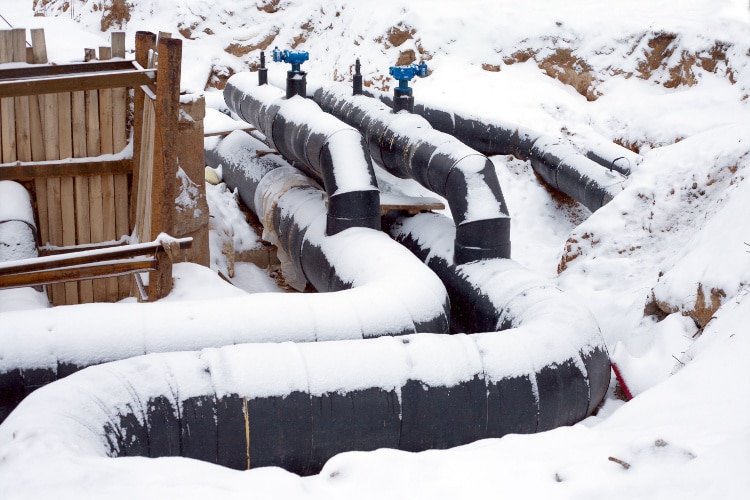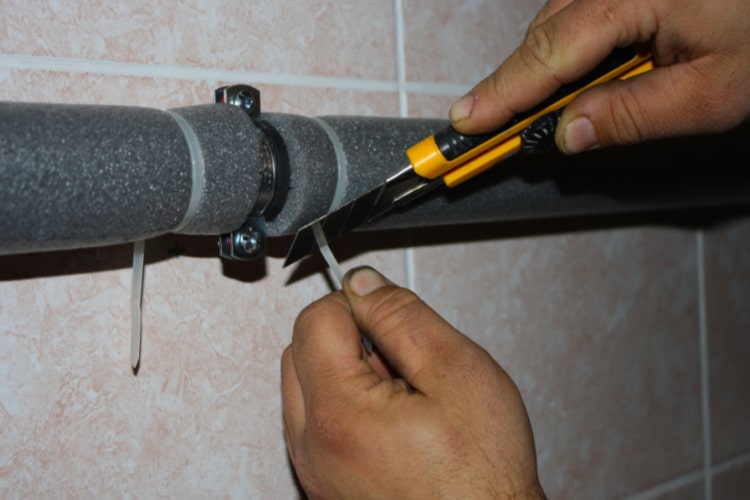Water pipes can freeze when the temperature falls below 32 degrees Fahrenheit. While water may not freeze inside the well, it certainly is much more likely to freeze as it moves into pipes in the building.
If you have frozen pipes in your house, you should deal with it right away. Otherwise, you run the risk of pipes bursting from the expansion of large volume of frozen water in them.
So, let’s show you how you can locate the frozen pipes and unfreeze them.

Unfreezing Frozen Water Pipes
There are a number of approaches that you can take to defrost your pipes.
If the frost isn’t severe and it looks like it might defrost by itself, it may be fine to just wait. Just stay mindful that you don’t leave the pipes frozen for more than a couple of days.
If one or more faucets aren’t working, you should try to follow the pipe from the faucet to locate the frozen area. Check for cracks and leaks throughout the pipe and call a professional immediately if you find any. If the worst has happened, and your pipes have already cracked, that’s not something you can easily fix on your own.
If there are no cracks, you can start thawing the pipes. Just make sure you leave the faucet open before you start so that the water in the pipes can drip through the faucet as it melts.
Step 1: Shut Off the Main Water Valve
Before you unfreeze your water pipes, you have to make sure that the main water supply valve is shut off.
You’ll most likely find this valve around the beginning of your water line. If you’re unsure where the water line enters your home, check the basement and around your pressure tank, as well as your water heater. If there’s a lever, the valve handle should be perpendicular to the pipe. This is how you know for certain that it is shut correctly. If you’re dealing with a wheel valve, turn it counter-clockwise.
Before thawing your pipes, remember to shut off the water heater. If you have water softening or filtration systems, unplug those as well.
Step 2: Locate the Frozen Pipes
To find frozen pipes, you’ll need to work backward from the faucet that is not delivering water. Keep an open eye for condensation and frost coating along the pipes that are out in the open.
Another way of locating the frozen spot is to tap the pipes with a metal object and listen for sounds. If it sounds hollow, it means the frozen water is elsewhere. But if you happen to hit a spot that sounds full, you’ve probably struck ice.
You may also come across instances where your pipes are completely frozen. In this case, the sound test might confuse you because you will only be getting one sound throughout. You should call a professional if that’s the case.
Remember to check all pipes in your building, including the ones in your garage and yard.
Step 3: Check for Hidden Pipes
Unfortunately, sometimes water pipes are situated behind large objects, in areas that are out of reach, or inside walls.
The good news is that, since these pipes are enclosed, they are also less likely to be exposed to low temperatures. Nevertheless, when they freeze, you should fire up your heating systems to deliver as much heat as possible.
If you suspect that the frozen pipes are inside the wall, you should consult a professional plumber with the right tools for the job.
Step 4: Warm Up the Pipes
Once you successfully locate the frozen pipes, it’s time to thaw them.
You can wrap towels soaked with hot water around the pipes or a heat lamp to thaw the ice. A portable hair dryer can be helpful as well. Move it up and down the pipe for best results.
You should never use open flame heaters, such as a blowtorch or a lighter, to defrost the pipes. They can damage your pipes or even cause a fire.
Get Professional Help
If the process seems daunting, we recommend you consult with or hire a professional, especially if you suspect a section of the plumbing has already cracked or it’s in a location that’s not easily reachable.
How to Prevent Water Pipes From Freezing
So far, we’ve only talked about what you can do to fix the problem, but it’s even better to do everything you can to prevent it from happening. There are a couple of measures you can take before winter to prevent frozen pipes, including pipe insulation or letting your faucets trickle to keep water flowing.
Before you take precautions, make sure that your pipes are not already frozen. If you run across icy patches, follow our previous suggestions to fix the issue.
Insulate the Pipes
Pipe insulation is a great idea to prevent pipes from freezing. To insulate pipes, you will have to measure the pipe’s length and get insulation material. You can use fiberglass wrap and foam sleeves.

Sweatshirts or blankets might work too, but they are less effective. You’d need to wrap them in thick layers for them to actually be effective.
If you have pipes in outside areas, you can build enclosures around them to minimize their exposure to cold. Seal up holes or openings that can let in cold air.
Attend to Pipes Inside Walls
When temperatures are extremely low, keeping cabinet and bathroom doors open is a good idea to prevent pipes inside wall from freezing. The pipes that stretch behind will be exposed to more heat and will be less likely to freeze.
Let the Faucets Drip
Running water is a lot less likely to freeze than still water. You can prevent pipes from freezing by letting your faucets drip water.
Insulate the Well House
Build a well house around your well pump and insulate other above-ground pipes.
You can also warm up the well house by installing a thermostat-controlled ceramic heater or a light bulb.
Use Heat Tape
Heat tapes are electric cables attached to water pipes to protect them from freezing. They’re great at keeping the pipes warm at all times. Plus, there are self-regulating heat tapes that change the wattage output depending on the weather.
Heat tapes are a good solution if you live in a cold climate. However, since they are electric cables, you must properly install and maintain them to prevent accidents.
Inspect & Maintain your Well before Winter
If you can afford it, have your well and pipes inspected before winter. This way, you’ll be aware of any cracks, well pump and water tank issues that could lead to damage or freezing.
Conclusion
If you have frozen pipes, find the frozen spot or area and check for cracks. You can solve the problem without professional help if there are no cracks or leaks.
Start by shutting off the main water supply and locating the frozen pipes. You can use a hair dryer, a heat lamp, or hot towels to thaw the pipes.
Ideally, you also want to take preventative measures. In winter, let the faucets drip to keep the water from getting stagnant. Make sure to insulate your pipes as well.